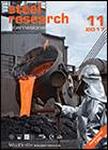版权所有:内蒙古大学图书馆 技术提供:维普资讯• 智图
内蒙古自治区呼和浩特市赛罕区大学西街235号 邮编: 010021

作者机构:Tech Univ Bergakad Freiberg Inst Mech & Fluiddynam D-09599 Freiberg Germany Helmholtz Zentrum Dresden Rossendorf Inst Fluiddynam D-01328 Dresden Germany
出 版 物:《STEEL RESEARCH INTERNATIONAL》 (Steel Res. Int.)
年 卷 期:2015年第86卷第4期
页 面:400-410页
核心收录:
学科分类:080602[工学-钢铁冶金] 0806[工学-冶金工程] 08[工学]
基 金:Helmholtz Association of German Research Centers e.V
主 题:mini-LIMMCAST mold flow OpenFOAM RANS unsteady URANS
摘 要:A time resolving numerical model of single phase mold flows is formulated in the frame of Reynolds-averaged Navier-Stokes (RANS) simulations. Three revised eddy viscosity turbulence models besides the often used Standard k-epsilon model for steady and unsteady RANS simulations are evaluated with the computational fluid dynamics (CFD) software tool OpenFOAM. The performance of the numerical model and the different turbulence models is tested with help of the mini-LIMMCAST facility. Numerical data are compared with experimental results focusing especially on the jet flow region. The different turbulence models lead to slight deviations from the experimental data in the case of steady state calculation. For the time-averaged unsteady RANS equations (URANS) results, a crucial influence by the discretization order is observed. In the case of unsteady results a mix between first and higher order accuracy schemes is necessary for representative results. The use of the Standard k-epsilon model and the RLZ k-epsilon model can lead to unstable behavior in the case of URANS simulations. The study concludes, that in the case of qualitative, temporally resolved informations, and temporally averaged results, an unsteady RANS simulation can keep up with a large eddy simulations (LES).